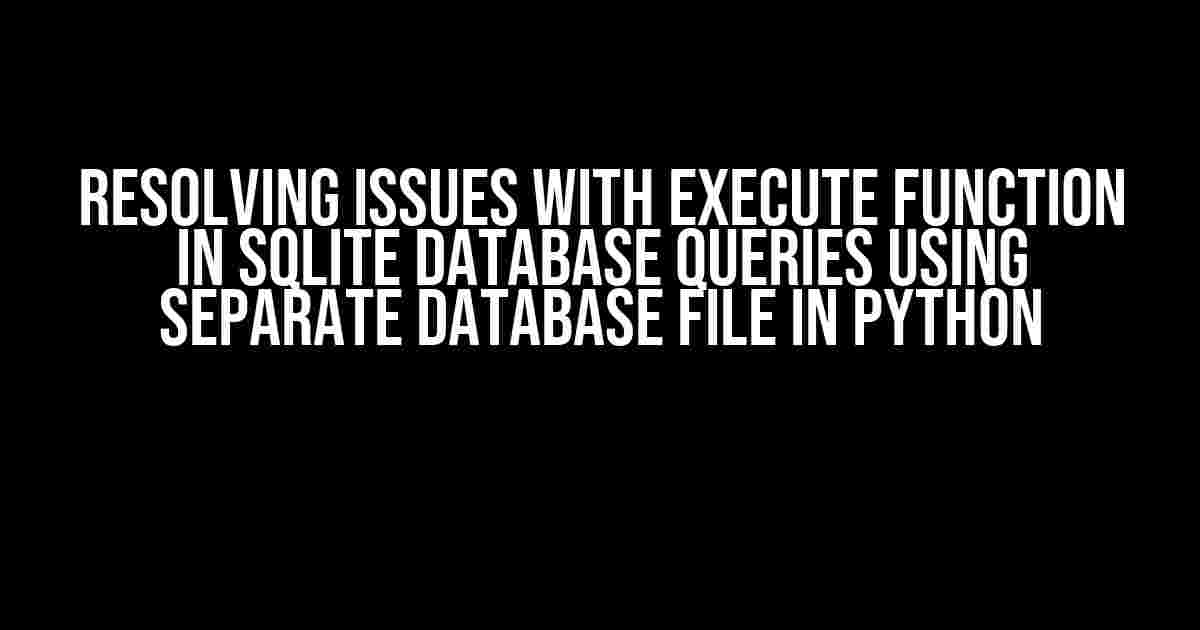When working with SQLite databases in Python, it’s a good practice to separate database queries into a separate file to maintain modularity and reusability of code. However, sometimes developers may face issues with the execute function while trying to execute database queries. In this article, we’ll explore the possible reasons behind this issue and provide solutions to overcome it.
Background: Separating Database Queries into a Separate File
When designing a Python application that interacts with a SQLite database, it’s common to have multiple modules or files that perform different functions. To keep the code organized, it’s a good idea to create a separate file for handling database queries. This approach makes it easier to maintain and update the database schema without affecting other parts of the application.
For instance, let’s assume we have a file called `database_queries.py` that contains functions for executing different database queries:
# database_queries.py
import sqlite3
def create_connection(db_file):
conn = None
try:
conn = sqlite3.connect(db_file)
return conn
except Error as e:
print(e)
def execute_query(conn, query):
try:
cur = conn.cursor()
cur.execute(query)
conn.commit()
return cur.fetchall()
except Error as e:
print(e)
The Issue: Execute Function Not Working as Expected
When trying to execute a query using the `execute_query` function, developers may encounter issues with the execute function not working as expected. This could be due to various reasons, such as:
- Database connection not established correctly
- Invalid SQL query syntax
- Query parameters not properly formatted
- Database file not found or inaccessible
Solutions to Resolve the Issue
To resolve the issue with the execute function, follow these steps:
-
Verify the database connection: Ensure that the database connection is established correctly using the `create_connection` function. Check if the database file path is correct and the connection is not None.
-
Validate the SQL query syntax: Make sure the SQL query syntax is correct and does not contain any errors. Use tools like SQLite Studio or DB Browser to test the query separately.
-
Format query parameters correctly: Ensure that query parameters are properly formatted and passed to the `execute_query` function.
-
Check database file accessibility: Verify that the database file is accessible and has the correct permissions. If the file is located in a different directory, ensure that the path is correct.
Conclusion
In conclusion, when facing issues with the execute function in a separate database file for SQLite database queries in Python, it’s essential to check the database connection, SQL query syntax, query parameters, and database file accessibility. By following the solutions outlined in this article, developers can resolve the issue and ensure that their database queries execute correctly.
Frequently Asked Question
Stuck with executing database queries in SQLite database using Python? Don’t worry, we’ve got you covered! Here are some frequently asked questions and answers to help you overcome the hurdles.
What is the purpose of creating a separate database file for handling database queries in SQLite?
Creating a separate database file allows you to organize and manage your database queries more efficiently. It helps to keep your code clean and structured, making it easier to maintain and scale your application. Additionally, it enables you to reuse your database logic across different parts of your application.
How do I connect to my SQLite database using Python?
To connect to your SQLite database using Python, you need to import the sqlite3 module and create a connection object. You can do this by using the following code: `conn = sqlite3.connect(‘database.db’)`. Replace ‘database.db’ with the name of your database file.
What is the execute function in SQLite, and how do I use it?
The execute function is a method of the cursor object in SQLite that allows you to execute a SQL query. You can use it to perform CRUD (Create, Read, Update, Delete) operations on your database. To use the execute function, you need to create a cursor object using the connection object, and then call the execute method on the cursor object, passing the SQL query as an argument.
Why am I facing issues with the execute function in my SQLite database?
There could be several reasons why you’re facing issues with the execute function. Some common reasons include incorrect SQL syntax, missing table or column names, or insufficient permissions. Make sure to check your SQL query for errors, and verify that you have the necessary permissions to execute the query.
How do I debug my SQLite database queries in Python?
To debug your SQLite database queries in Python, you can use various techniques such as printing the SQL query before executing it, using the `try-except` block to catch errors, or using a debugger like pdb to step through your code. You can also use the `rowcount` attribute of the cursor object to check the number of rows affected by the query.



